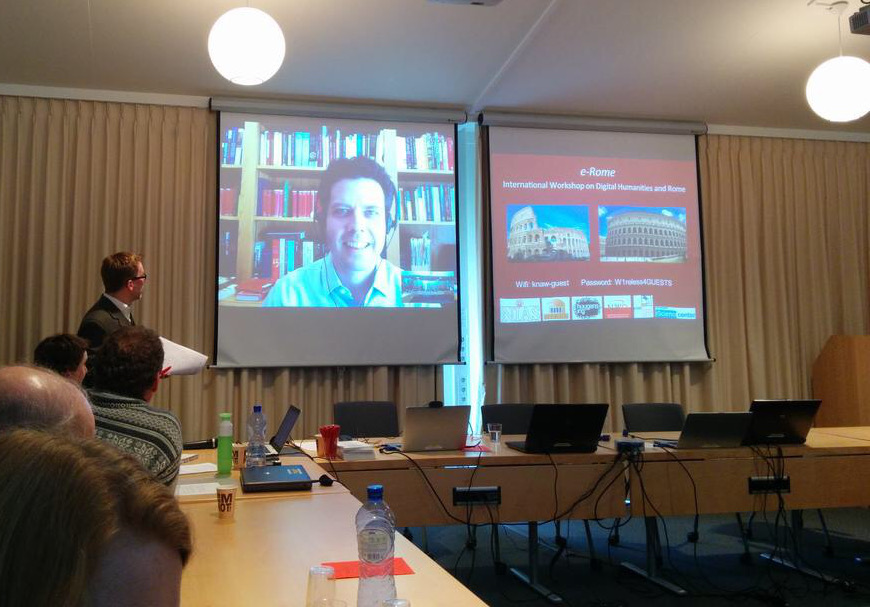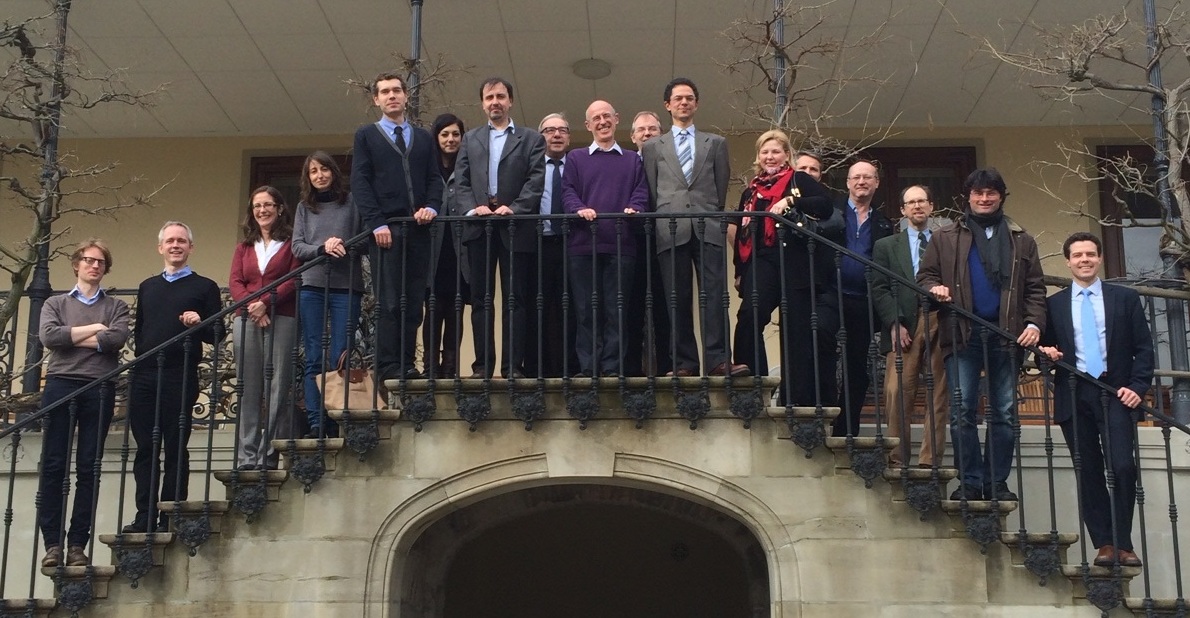Neil gave a presentation on Tesserae at the eRome International Workshop on Digital Humanities and Rome held in Wassenaar, Netherlands, on March 4, 2015. The conference program is here.
Intertextualité et Humanités Numériques
Participants in the Intertextualité et Humanités Numériques workshop enjoying a moment outdoors at the Fondation Hardt. Pictured are (left to right): Yannick Zanetti, Valéry Berlincourt, Lavinia Galli Milic, Chiara Battistella, Christopher Forstall, Martina Mastandrea, Massimo Manca, Paolo Mastandrea, Gregory Hutchinson, Damien Nelis, Neil Bernstein, Monica Berti, Marco Büchler, Michael Dewar, Stephen Wheeler, Cristiano Castelletti, and Neil Coffee.
Read the workshop program PROGRAM and see more PICTURES.
Participants were asked to give responses in the form of short blog posts, most of which were produced in a dedicated one-hour session at the workshop. You can find these below, along with materials on the research of participants.
Response of Michael Dewar
As I said to more than one person in the course of the workshop, I had expected that I would learn far more than I would be able to contribute. And so it turned out. The presentations of Marco Büchler and Monica Berti, for instance, were a very salutary reminder of the need to frame useful – that is, usefully defined and limited – questions if you are hoping to hope to make sense of what a vast but searchable digital bank of texts has to offer. The presentation of the ‘Musisque Deoque’ team made clear to me how wrong I have been in thinking that I was making good use of their material: in truth, I now know that I had no idea just what, in particular, ‘pede certo’ is capable of. And Paolo Mastandrea has made me a very happy man by providing so much evidence of one particularly fascinating, and largely unexpected, case of the ‘reuse’ of a canonical poet: the idea that Corippus may have had access to a copy of Ennius, and made repeated use of it, was a true revelation.
Response of Damien Nelis
As part of a research project funded by the Swiss National Science Foundation and devoted to the study of intertextuality in Flavian epic poetry, the Classics Departments of the University at Buffalo, SUNY and the University of Geneva organized an international workshop to discuss intertextuality and the digital humanities. The Fondation Hardt in the Commune of Vandoeuvres, on the outskirts of Geneva provided an idyllic location for two days of rich and intense discussions about. Interaction between scholars involved in on-going digital projects and scholars who have done important work in the field of Greek and Latin intertextuality based on traditional scholarly methods helped to clarify a number of key issues and raise some important questions:
eTRACES / eTRAP by Marco Büchler
Marco Büchler delivered a presentation on his text reuse research with eTRACES / eTRAP, slides for which are available here.
Intertextuality Beyond Words by David Bamman
The talk I was to give in Geneva (before weather sadly prevented my arrival) focused on “intertextuality beyond words” — I want to take this blog post to at least partially sketch out what I mean by that somewhat cryptic title. Most approaches to text reuse now, both in the IR world of identifying duplicate or near-duplicate documents, and in more humanistic approaches that explicitly focus on deliberate literary allusions (Lee 2007, Bamman and Crane 2008, Forstall et al. 2011, Büchler et al. 2012, Coffee et al. 2012) treat strings — i.e., sequences of characters, or words — as the atomic unit of comparison. Ovid’s Arma gravi numero violentaque bella parabam // edere is an allusion to Vergil’s Arma virumque cano for having several identical tokens, enclitics and rephrasings (parabam edere <-> cano) that are locally similar at the lexical and phrasal level. Lots of work in text reuse now focuses both on the fundamental problems of 1.) rigorously defining how we judge two things to be similar (an easy question for exact string matching but significantly harder for more distant but semantically similar pairs of text) and 2.) identifying examples of reuse at scale, when N2 brute-force comparisons is simply not feasible (Smith et al. 2013).
Response of Lavinia Galli Milic
Les humanités numériques nous invitent à repenser l’intertextualité car elles changent notre rapport au texte antique. À présent qu’il est possible de déceler une masse de points de contact individuels entre deux textes en un clic de souris, le collapse interprétatif guette le philologue qui ne tiendrait pas aussi compte des relations extensives entre les deux textes en question. Mais le risque est moindre par rapport aux nombreux avantages que ces nouveaux outils offrent aux chercheurs, les rapprochant du lecteur ‘idéal’.
Response of Chiara Battistella
Taking part in this workshop has been an extraordinary opportunity both to get to know people directly involved in Digital Humanities projects (Tesserae, Musisque Deoque, LOFTS, E-Traces) and better understand the state of the art and what lies ‘behind the scenes’ in terms of technical aspects. I especially appreciated the felicitous combination of more general and theoretical discussion on the issue of intertextuality from a digital standpoint with the illustration of more specific case studies, which have shown how and to what extent Classicists may benefit from DH. Classical scholars will not have to turn all of a sudden into computer scientists, since interpretation will continue to remain key to the field – and this is great news! However, I fully agree that embracing traditional methods and digital tools is what our discipline will ideally need in the near future and what will make it appealing to future generations.
As far as the Tesserae project is concerned, I very much look forward to the improvements of the Latin-Greek search tool!
Intertextualité et humanités numériques workshop
Tesserae team members Neil Coffee and Christopher Forstall took part in the workshop Intertextualité et humanités numériques co-organized by Coffee and Damien Nelis of the University of Geneva Classics. Read more on the workshop page.
Response of Christopher Forstall
Over the course of the past two days, here at the beautiful grounds of the Fondation Hardt, we have been inspired and challenged by diverse new work—both literary and digital—on issues of intertextuality in Classical texts and beyond. In particular, I was thrilled to see the elegance with which the team from Musisque Deoque has combined phonological, metrical and lexical features in their online search tools for Latin poetry. I was also excited by the way in which both digital and non-digital scholars were rethinking the boundaries of intertext, especially with respect the constraints of poetic form and of memory. Not only the ideas, but also the modes of thought and communication have been varied, from traditional close readings to real-time software demonstrations, with lectures and presentations in English, French, and Italian, intense discussions in small breakout groups, relaxed conversations over wine and coffee, and now even ex tempore composition of blog entries.
I’ve made a couple of resolutions over the course of these meetings, and perhaps if I state them publicly here I’ll be forced to keep at least some. In no particular order:


